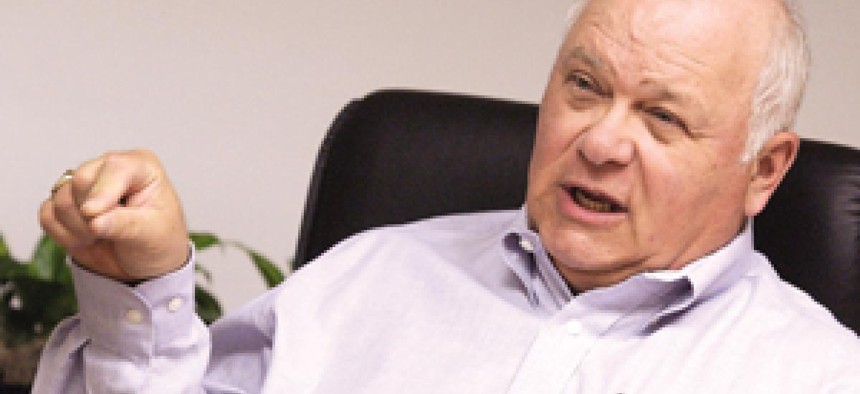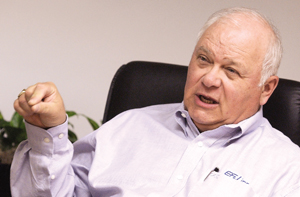After barely surviving, EFJ thrives

When Michael Jalbert came to E.F. Johnson Inc. in early 1999, the company was losing money, had been delisted from Nasdaq and was facing class action lawsuits from shareholders.

Getting relisted on the Nasdaq " raises our visibility and allows us to attract better investors," said EFJ's Michael Jalbert. "It gives us credibility."
David S. Spence
Wireless equipment maker rides government market to profitability
When Michael Jalbert came to E.F. Johnson Inc. in early 1999, the company was losing money, had been delisted from Nasdaq and was facing class action lawsuits from shareholders.
And then things got worse.
"You always find more problems once you come on board," said Jalbert, the company's chairman, president and chief executive officer, who has led turnarounds at five other companies during his career.
In 2000, the company's stock on the Over the Counter Bulletin, where stocks of delisted companies are traded, hit a low of 22 cents. Cash reserves at the Washington-based maker of wireless communications equipment were so low that the company teetered close to bankruptcy.
So it was an occasion of some note when last month, Nasdaq allowed EFJ to return to the exchange under the ticker symbol EFJI. On Feb. 19, the company began trading and closed that day at $7.30. On March 15, it closed at $5.12, more than 20 times its 2000 low.
EFJ's turnaround can be attributed to many factors, most notably a plan by Jalbert and his team to discontinue old product lines and concentrate on its core markets such as federal, state and local governments. But it took some fancy footwork to keep the company afloat long enough for the strategy to pay off.
In November 2000, after the company's accountants expressed concerns that the nearly 80-year-old company didn't have enough money to survive, EFJ was forced to let go 140 people -- about a third of the company.
"We had to get costs out of the organization real quick," Jalbert said.
The move gave the company the time necessary for the new strategy to succeed.
After posting a net loss of $25 million in 2000 on $42.2 million in revenue, EFJ became profitable in 2001, making a net of $544,000 on $44.2 million in revenue. Profits continued to improve in 2002, with EFJ reporting $1.4 million in net earnings on $40.8 million in revenue, according to its filings with the Securities and Exchange Commission.
For 2003, the company posted net earnings of $4 million on revenue of $56.2 million.
Getting relisted was a milestone for the company, but not an end itself, Jalbert said.
"It raises our visibility and allows us to attract better investors," he said. "It gives us credibility."
EFJ's comeback has been helped by a changing market place as radio interoperability initiatives are pushing federal and state agencies to move their wireless communications systems from analog technology to digital.
The company counts among its customers state and local police, fire and rescue workers as well as federal agencies with public safety responsibilities, such as the departments of Defense, Treasury, Interior, Transportation and the FBI.
The federal government is its biggest customer, accounting for 60 percent of its revenue. The state and local market accounts for about 20 percent, and the remainder comes from its Transcrypt business, which offers encryption technology.
Positioning EFJ for the transition from analog to digital was one of Jalbert's top priorities. While the company was developing digital radios when he came on board, it still had plenty of old ones. When Jalbert took over the company, it was making 43 different radios.
"One of the things we had to do was get down to as few platforms as we could," he said. "Today, we are down to five, and we'll probably be down to three by the end of the year."
The new radios are software driven. "They are now computers," he said. Features can be added or taken away via programming.
The push for digital radios started before the Sept. 11 terrorist attacks, but that event created a sense of urgency among federal agencies. That urgency is spreading among state and local governments, Jalbert said.
The sales momentum is picking up as more federal money is funneled to the states, so they can build interoperable radio systems that comply with the P25 wireless communications standard. The standard allows police, fire and rescue workers communicate with each other and their federal counterparts.
The company recently won a $663,000 contact to supply P25 radios to the Alaska Land Mobile Radio System, a project funded by the federal and Alaskan governments.
"Federal funding is really driving the state and local spending right now," Jalbert said. Eventually, the state and local business might be as big as the company's federal business.
EFJ's niche has been in supplying the handheld and mobile radios, known as subscriber units. The company's is now adding the infrastructure, such as base stations and routers, to its offerings.
The company has developed the Trunked Netelligent Infrastructure System, which it has sold to one federal customer so far. The company declined to name the customer.
Jalbert said developing infrastructure products is a major goal of the company's research and development budget. EFJ plans to spend about 15 percent of its 2004 revenue on research and development.
"We have a goal of being a much bigger company," he said. He is projecting annual growth of 20 percent to 25 percent.
As the company grows and broadens its product offerings, it will compete more with Motorola Inc. of Schaumburg, Ill., the dominant player in wireless communications.
"They control 90 percent of the market," Jalbert said. "But they are everything to everybody, and we are focused."
Senior Editor Nick Wakeman can be reached at nwakeman@postnewsweektech.com.
NEXT STORY: Brief: FISMA compliance module


